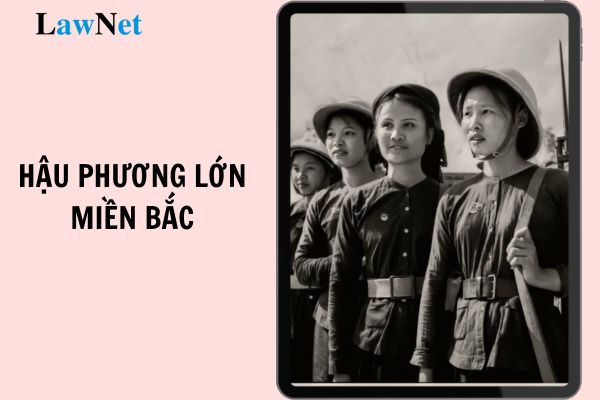What is the role of the Northern Great Rear in the resistance against the United States? What are the specific competencies required for upper secondary school students in History in Vietnam?
What is What is the role of the Northern Great Rear in the resistance against the United States?
During the resistance against the United States, the role of the Northern Great Rear was not only a solid rear but also a revolutionary base, playing a decisive role in supporting both personnel and resources to the southern frontline.
After the Geneva Agreement of 1954, the North became a strategic rear, where the Central Committee of the Communist Party, the Government of Vietnam, and the headquarters of the revolution were located, directly leading and directing the resistance war. From here, the Vietnamese Communist Party devised military, political, and diplomatic strategies to gradually defeat America's war strategies.
In addition, the North was also a place for training and nurturing cadres, and soldiers, and providing leadership forces to the South. The Central Bureau in the South and the Command of the Liberation Army in the South were all directed by the Northern Great Rear.
The North mobilized millions of youths to join the army, forming southern-bound military units to support the southern battlefield. Major campaigns such as the General Offensive and Uprising during the Tet Mau Than of 1968, the Highway 9 - Southern Laos Campaign of 1971, and the Ho Chi Minh Campaign of 1975 all benefited significantly from forces trained in the North.
Moreover, tens of thousands of youth volunteers and logistics personnel participated in road building and ensured transportation, contributing to maintaining the support line from North to South.
In terms of material resources, the Northern Great Rear focused on developing the national defense industry, producing weapons, ammunition, vehicles, and military supplies to supply battlefields. The Ho Chi Minh Trail, both on land and at sea, was a strategic transport route, enabling the North to continuously transfer troops, weapons, and food to the South. Northern localities boosted agricultural production to ensure the provision of food and supplies to the military and the people of the South.
Though acting as a rear, the North was also a frontline when the U.S. conducted destructive wars using air and naval forces. Notably, during the two air raid periods (1965-1968 and 1972), the North courageously resisted, shooting down thousands of American aircraft, and ensuring the safety of production facilities and support routes.
The "Dien Bien Phu in the air" battle in December 1972 thwarted U.S. schemes, forcing Washington to sign the Paris Agreement of 1973, and withdraw troops from the South, laying the groundwork for the victory in 1975.

What is the role of the Northern Great Rear in the resistance against the United States? What are the specific competencies required for upper secondary school students in History in Vietnam? (Image from the Internet)
What are the specific competencies required for upper secondary school students in History in Vietnam?
Under Section IV of the General Education Program issued in conjunction with Circular 32/2018/TT-BGDDT amended by Article 2 Circular 13/2022/TT-BGDDT, the specific competencies required for upper secondary school students in History in Vietnam are as follows:
The History curriculum helps students develop historical competency based on basic and advanced knowledge of world, regional, and Vietnamese history through themes and topics on political, economic, social, cultural, and civilizational history. Historical competency consists of components like understanding history; recognizing and thinking critically about history; and applying acquired knowledge and skills.
The specific competencies required for upper secondary school students in History in Vietnam include:
(1) Understanding history:
- Recognize different types of historical documents; understand the content, exploit and utilize historical documents in the learning process.
- Reconstruct and present, verbally or in writing, the course of historical events, figures, and processes from simple to complex; identify historical events in specific space and time.
(2) Historical awareness and thinking:
- Explain the origins and movements of historical events from simple to complex; point out the historical development process in chronological and synchronous order; compare similarities and differences between historical events, and explain causal relationships in the historical process.
- Provide personal remarks and evaluations of historical events, figures, and processes based on historical awareness and thinking; understand historical continuity and change; know how to think in diverse directions when considering, evaluating, or seeking answers about a historical event, figure, or process.
(3) Applying learned knowledge and skills:
- Draw historical lessons and apply historical knowledge to explain real-life issues; based on that, have the ability to self-study historical issues, develop creative capacity, have the ability to access and process information from different sources, and have the awareness and ability for lifelong self-study of history.
What are the objectives of the History curricula at the upper secondary level in Vietnam?
Under the General Education Program for History issued together with Circular 32/2018/TT-BGDDT, the objectives of the History curricula at the upper secondary level in Vietnam are stated as follows:
The History curriculum helps students enhance historical competency, an expression of scientific ability formed in secondary school; contributes to educating national spirit, patriotism, the fine traditional values of the nation, human cultural essences, and the qualities and competencies of Vietnamese citizens, global citizens in line with developmental trends of the era; assisting students in accessing and clearly perceiving the roles and characteristics of historical science, as well as the connection between history and other scientific fields and professions, thereby establishing a foundation for career orientation in the future.

